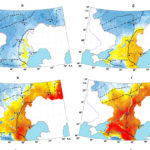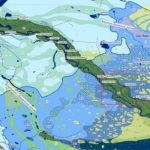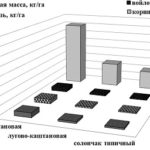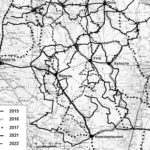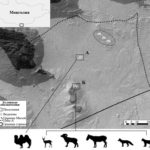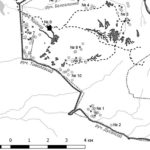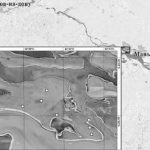MODERN CLIMATE TRENDS OF CHANGES IN EVAPORATION AND SOIL MOISTURE IN THE SOUTH OF EUROPEAN RUSSIA
UDC 551.573:551.579.5(470)
Titkova T.B., Zolotokrylin A.N., Cherenkova E.A. MODERN CLIMATE TRENDS OF CHANGES IN EVAPORATION AND SOIL MOISTURE IN THE SOUTH OF EUROPEAN RUSSIA // Arid Ecosystems. 2023. Vol. 29. № 3 (96). P. 4-14. | PDF
We studied an impact that climate parameters had on evaporation during the active growing season of plant in forest steppe, steppe and semiarid areas in 1980-2021, in the south of European Russia. We analyzed the main patterns of the connection between evaporation and soil moisture. At the beginning of the growing season, a change in evaporation in forest and steppe was largely determined by the positive connection with temperature and wind. In the middle of the season, the role of precipitation and wind increased even more. Starting in July, the connection between evaporation and air temperature turned negative due to the water shortages in dry subhumid and semiarid climates. At the beginning, the connection between evaporation and surface moisture was negative, and the surface evaporation was minimal since the soil cover was not yet warm enough in steppe and forest steppe zones. However, this connection was positive in warm soil in the semidesert. Starting from the middle of the season and until its end, the connection between evaporation and soil moisture was significantly positive everywhere from forest steppe to semiarid zones. At the beginning, the continuous warming increased the evaporation. In the middle and the end, evaporation trends were significantly negative because the insufficient moisture at higher temperatures resulted in drying of the soil cover and early vegetation decay. The largest evaporation decline was noted in steppe and dry steppe landscapes, caused by the overall drying of the territory when the air temperatures grew, as well as by the decrease both of precipitation and the average wind speed. Surface moisture trends were mostly negative in the south of European Russia, with the maximum moisture loss in broadleaf forests and forest steppe because they were more humid compared to dry steppe and semiarid zones. Changes in soil moisture in the semiarid zone throughout the entire warm period were minimal.
Keywords: evaporation, air temperature, precipitation, wind, soil moisture, natural zones, growing season.
Financing. The study of the influence of climatic parameters on evaporation was carried out within the framework of scientific topic No. 0127-2019-0010 (AAAA19-119102890091-1) “Development of Scientific Foundations for Sustainable Management of Natural and Anthropogenic Systems Based on Balanced Land Use Models”; the analysis of trends in abnormal regimes of soil moisture was financially supported by the Russian Science Foundation, project No. 19-17-00242.
DOI: 10.24412/1993-3916-2023-3-4-14
EDN: ZUWGEV
THE GEOMORPHOLOGICAL INTERACTION BETWEEN THE TERRAIN OF THE BAER KNOLLS AND THE VOLGA PALAEODELTAS AT THE END OF THE KHVALYNSK TIME
UDC 551.79; 551.351.2(262.81); 551.89; 551.468.6
Lobacheva D.M., Badyukova E.N., Makshaev R.R. THE GEOMORPHOLOGICAL INTERACTION BETWEEN THE TERRAIN OF THE BAER KNOLLS AND THE VOLGA PALAEODELTAS AT THE END OF THE KHVALYNSK TIME // Arid Ecosystems. 2023. Vol. 29. № 3 (96). P. 15-23. | PDF
Many geological sections in the ledge of the Lower Volga valley have been actively studied since the end of the 19th century. Results of many years of field work showed that alluvial sediments of the Khvalynsk time (end of the late Pleistocene – early Holocene) are absent in all the studied quaternary sections along the valley. Numerous literary sources, maps and descriptions of wells were used for this research. We conducted geomorphological mapping in ArcGIS using the SRTM DEM and studied many outcrops and wells and carried out field surveys along the Volga valley and in the Baer’s knolls, the giant underwater dunes of the Northern Caspian region. We consider that in the Khvalynsk time the Volga River probably did not run through the site of its current location. In this regard, the question arises of where the Volga channel was located in the North-Western Caspian region. Thus, we propose that the western branch of the Volga ran along the foot of the Eastern Yergeni slopes and eroded the surface of the marine plain, which resulted in the formation of the Sarpinsko-Davanskaya Hollow. Meanwhile, its eastern branches ran into the Khaki Saline, which was one of the estuaries of the Northern Caspian region, where one of the eastern channels of the Paleo Volga probably were flowing into. In the Khvalynsk time, in the lower reaches of the Volga channel there were multiple terminal distributary channels. The large branching delta was much larger (about 200-210 km wide) than the modern delta and somewhat reminiscent of the modern delta of the Lena river in size. Where the modern Volga-Akhtuba floodplain is located now, there was probably a small central branch, in the west there was a Sarpinsky branch, and in the east, an Elton-Khaki branch. They were interconnected by an extensive system of branches, the relief of which is still preserved. At the very end of the Late Khvalynsk time, the Sarpa and Khaki branches began to die off, and most of the water began to run along the central branch, forming the modern Volga-Akhtuba valley.
Keywords: Volga Delta, Caspian Sea, Lower Volga, Baer’s knolls, geomorphology and paleogeography, Late Pleistocene, Khvalynsk time, giant river dunes.
Financing. This work was supported by a grant No. 20-05-00608 “Evolution of the Natural Environment of the Middle Volga Region in the Late Pleistocene: Chronology, Climatorythmics and Correlation with the Events of the Caspian Region”.
DOI: 10.24412/1993-3916-2023-3-15-23
EDN: VTESSF
HARMONIZATION OF THE RESULTS OF SOIL SALINITY CHEMICAL STUDY
UDC 631.4
Prokopyeva K.O., Konyushkova M.V. HARMONIZATION OF THE RESULTS OF SOIL SALINITY CHEMICAL STUDY // Arid Ecosystems. 2023. Vol. 29. № 3 (96). P. 24-35. | PDF
Soil salinity is one of the main ecological factors that limits the growth and productivity of many plants. Its assessment in different countries is carried out by different methods. In Russia and some other countries, soil salinity is assessed using water extracts. Internationally, the method of electric conductivity of soil paste extracts is widely used. These methods are labor-consuming, and, therefore, the reduced methods are used to assess soil salinity for mass analysis. Thus, in Russia, salt surveys are often evaluated by the leading toxic ion (chlorine or sodium). In a number of foreign countries assessment is given by electrical conductivity at various ratios of soil to water (1: 1; 1: 2.5; 1: 5; 1: 10). In this study, comparisons of different methods for substantiation of possibility to use electrical conductivity measurement in 1: 5 suspension were carried out. The following methods were compared: 1 – method of determination of specific electric conductivity in water suspension (1: 5); 2 – method of determination of pNa and pCl measured in water suspension (1: 5) using ion-selective electrodes; 3 – determination of sodium in water suspension (1: 5) by atomic absorption spectrometry. Salinity was evaluated in samples of light clayey soils of the dry steppe zone of mainly chloride-sodium salinity type. The results showed that when determining the activity of ions, the greatest correlation was observed between measurements of specific conductivity (conductometer) and sodium activity (ion-selective electrodes). A sufficiently close correlation between specific conductivity and the content of sodium ions in the water extract was revealed and the function of recalculation of these indicators was obtained: ЕС1: 5 = 0.213Na1: 5 + 0.17 (with intercept); ЕС1: 5 = 0.23Na1: 5 (without intercept). For evaluation of salinity degree according to specific conductivity index (1: 5) the following criteria are suggested: 0-0.4 dS/m (non-saline), 0.4-0.6 dS/m (slightly saline), 0.6-1 dS/m (medium saline), 1-1.9 dS/m (strongly saline), > 1.9 dS/m (very strongly saline). When comparing different gradations of soil salinity with the help of contingency tables using chi-square and kappa index, the presence of statistically significant contingency was revealed, which allows us to use different methods of soil analysis to assess the degree of salinity.
Keywords: salinity, soil analysis, electrical conductivity, ion selective electrodes (ISE), sodium, Caspian Lowland.
Financing. The work was supported by the funds for the Eurasian Center for Food Security of Lomonosov Moscow State University (Decree No. 1736-r, dated 26/06/2021).
DOI: 10.24412/1993-3916-2023-3-24-35
EDN: WCVAFO
ON THE NITROGEN BALANCE IN THE SOIL AND VEGETATION COVER OF ARID ECOSYSTEMS IN THE NORTH-WESTERN PRECASPIAN
UDC 551.509.22 (470.67)
Asvarova T.A., Gasanov G.N., Gadzhiev K.M., Bashirov R.R., Gimbatova K.B., Abdulaeva A.S. ON THE NITROGEN BALANCE IN THE SOIL AND VEGETATION COVER OF ARID ECOSYSTEMS IN THE NORTH-WESTERN PRECASPIAN // Arid Ecosystems. 2023. Vol. 29. № 3 (96). P. 36-45. | PDF
In this article we present the results of studies on the accumulation and translocation of phytomass estimated by blocks of plant matter, nitrogen concentration and nitrogen reserves. We estimated the compensation of the nitrogen balance in light chestnut and meadow-chestnut soils and typical solonchaks in the grass ecosystems of the North-Western Precaspian under the conditions of aridization and desertification.
Keywords: nitrogen, nitrogen reserves, nitrogen balance, phytomass accumulation, plant matter blocks, green mass, rags, felt, aridization, desertification.
Financing. The work was carried for the state task of the Caspian Institute of Biological Resources of the Dagestan Federal Research Center of the Russian Academy of Sciences “Monitoring and Forecasting of Soil Cover Dynamics and Bioproductivity of Landscapes of the Northwestern Caspian and Dagestan Part of the Eastern Caucasus”, Section 2, No. AAAA-A20-120062990014-2 “Bioproductivity of Landscapes and Nitrogen and Carbon Balances in Ecosystems Exposed to Natural-Anthropogenic Transformation of the North-Western Caspian Sea”, Topic 2, No. 122032200273-6.
DOI: 10.24412/1993-3916-2023-3-36-45
EDN: YBSEMS
THE ACTUAL VEGETATION MAP FOR THE TERRITORY OF DISTRIBUTION OF SAIGA TATARICA TATARIC L. POPULATION IN THE NORTH-WESTERN CASPIAN REGION
UDC 581.527.2; 581.527.5
Safronova I.N., Stepanova N.Yu., Karimova T.Yu., Kalmykova O.G., Ulanova S.S., Fedorova N.L., Goryaev I.A., Polyektov S.A., Polyakov D.G. THE ACTUAL VEGETATION MAP FOR THE TERRITORY OF DISTRIBUTION OF SAIGA TATARICA TATARIC L. POPULATION IN THE NORTH-WESTERN CASPIAN REGION // Arid Ecosystems. 2023. Vol. 29. № 3 (96). P. 46-56. | PDF
The map of the current vegetation on the territory of the present and expected distribution of the saiga population in the North-Western Caspian region is presented. The map was created under an agreement with the World Wildlife Fund (WWF) at a scale of 1:200,000 in the ArcGIS. Its legend contains 61 numbers, combined into 11 groups according to the dominant formation. In the steppe zone, fallows and pastures of different ages on slightly undulating and undulating plains with light-brown soils (Kastanozem by WRB) are represented by Stipa sareptana, Artemisia lerchiana communities on loamy and sandy loam soils in complex with Artemisia lerchiana and Leymus ramosus, Poa bulbosa, Agropyron desertorum on solonetz (I); Stipa sareptana, S. lessingiana, Festuca valesiaca, Agropyron desertorum, Poa bulbosa, Artemisia lerchiana, Tanacetum achilleifolium communities on loamy and sandy loam soils in complex with Artemisia lerchiana, A. pauciflora, Tanacetum achilleifolium on solonetz (II); Festuca valesiaca, Agropyron desertorum, Stipa sareptana, Leymus ramosus, Artemisia lerchiana communities on loamy and sandy loam saline soils in complex with Artemisia lerchiana, A. pauciflora, Tanacetum achilleifolium, Poa bulbosa, Leymus ramosus on solonetz (III); Poa bulbosa, Agropyron desertorum, Stipa sareptana, Leymus ramosus, Artemisia lerchiana, A. taurica, Tanacetum achilleifolium communities on loamy and sandy loam saline soils in complex with Artemisia taurica, A. lerchiana, A. pauciflora on solonetz (IV); Artemisia lerchiana, A. austriaca, Festuca valesiaca, Agropyron desertorum, Leymus ramosus and Festuca valesiaca, Poa bulbosa, Artemisia austriaca communities on loamy and sandy loam saline soils in complex with Artemisia pauciflora, A. santonica on solonetz (V). In the desert zone, pastures on hilly sands, undulating plains with brown desert (Calcisol by WRB) sandy and sandy loam soils are represented by Artemisia lerchiana, Poa bulbosa and Poa bulbosa, Artemisia lerchiana communities (VI); Artemisia lerchiana, Poa bulbosa communities on brown desert saline soils of light granulometric composition in complexes with Artemisia pauciflora, Poa bulbosa on solonetz (VII); complexes of Artemisia lerchiana, Poa bulbosa and Artemisia taurica, Poa bulbosa communities on brown desert saline soils of light granulometric composition (VIII); complexes of Poa bulbosa, Artemisia lerchiana and Poa bulbosa, Artemisia taurica communities on brown desert saline soils of light granulometric composition (IX); Artemisia lerchiana, Poa bulbosa communities on undulating sands, Calligonum aphyllum on hilly sands (X); Poa bulbosa, Stipa sareptana, S. caspia, Agropyron fragile, Sporobolus cryptandrus, annual (Ceratocarpus arenarius, etc.) communities on intensive pastures with brown desert sandy soils (XI).
Keywords: vegetation map, modern vegetation cover, steppe zone, desert zone, fallows, pastures, saiga antelopes.
Financing. The work was carried out under the research agreement No. 1/71 (30/04/2021) of the V.L. Komarov Botanical Institute of the Russian Academy of Sciences with the World Wildlife Fund “Assessment of Saiga Habitats of the Northwestern Caspian Sea”; the grant of the Russian Foundation for Basic Research No. 15-05-06773 “Vegetation Cover of the Caspian Lowland in the System of Botanical and Geographical Zoning”; on the topic No. 121032500047-1 of the Laboratory of General Geobotany of the V.L. Komarov Botanical Institute “Vegetation of European Russia and Northern Asia: Diversity, Dynamics, Principles of Organization”; under the state task No. 122042700002-6 of the N.V. Tsitsin Main Botanical Garden of the Russian Academy of Sciences; on the topic of the Institute of the Steppe of the Ural Branch of the Russian Academy of Sciences No. AAAAA21-121011190016-1; on the topic of the state task No. AAAAA18-118042490055-7 (0089-2021-0010) of the A.N. Severtsov Institute of Ecology and Evolution of the Russian Academy of Sciences “Fundamental Problems of Wildlife Conservation and Rational Use of Biological Resources”; on the topic of fundamental research plsnned for 2022-2024 of the Water Problems Institute of the Russian Academy of Sciences “Research of Geoecological Processes in Hydrological Systems of Land, Formation of Surface and Groundwater Quality, Problems of Water Resources Management and Water Use in the Conditions of Climate Change and Anthropogenic Impacts” (No. FMWZ-2022-0002), State registration No. AAAA-A18-118022090104-8; on the topic of the state task of the Institute for Integrated Research of Arid Territories “Monitoring the Current State of Pasture Resources of the Republic of Kalmykia Using Geoinformation Systems”. It was also supported by the Ministry of Education and Science of the Central Research and Development Center “Herbarium of the Main Botanical Garden of the Russian Academy of Sciences” (No. 075-15-2021-67).
DOI: 10.24412/1993-3916-2023-3-46-56
EDN: QSGELU
PATTERNS OF DISTRIBUTION OF ALLERGENIC PLANTS IN THE PLAIN BIOMES OF RUSSIA
UDC 581.9; 614.7; 911.3
Dikareva T.V., Rumiantsev V.Yu., Soldatov M.S., Malkhazova S.M. PATTERNS OF DISTRIBUTION OF ALLERGENIC PLANTS IN THE PLAIN BIOMES OF RUSSIA // Arid Ecosystems. 2023. Vol. 29. № 3 (96). P. 57-67. | PDF
In this paper we consider the list of species of allergenic plants as well as the species diversity of those plants as a whole in plain regional biomes of Russia. Statistical analysis of correlation between number of allergenic plants in the regional biomes and climatic indices was carried out made. The schematic maps were compiled and analyzed. It can be assumed that allergenic plants flowering during spring dominate the biomes of broadleaved forests and forest steppe, whereas the number of allergenic species flowering during summer is higher in forest-steppe and steppe biomes. The closest connection was detected between the number of species flowering during summer and average annual temperatures. Comparatively close connection was detected between the total number of allergenic species and average annual temperatures. Nevertheless, connection between the total numbers of allergenic plants in the studied biomes and the biomes aridity appeared to be weak.
Keywords: allergenic plants, regional biomes, climatic factors, aridity, correlation analysis, cartographic analysis.
Financing. The work was carried for the state task of the Lomonosov Moscow State University “Spatial and Temporal Organization of Ecosystems in the Conditions of Environmental Changes” No. CITIS 121051100137-4, as well as for the Development Program of the Interdisciplinary Scientific and Educational School of the Lomonosov Moscow State University “The Future of the Planet and Global Environmental Changes”.
DOI: 10.24412/1993-3916-2023-3-57-67
EDN: GIRHWI
CURRENT STATE OF CENOPOPULATIONS OF SOME ENDEMIC AND RARE SPECIES OF GENUS TULIPA L. (LILIACEAE) IN TASHKENT REGION (UZBEKISTAN)
UDC 581.4:55
Beshko N.Yu., Abduraimov O.S., Kadyrov U.Kh., Madaminov F.M., Makhmudov A.V. CURRENT STATE OF CENOPOPULATIONS OF SOME ENDEMIC AND RARE SPECIES OF GENUS TULIPA L. (LILIACEAE) IN TASHKENT REGION (UZBEKISTAN) // Arid Ecosystems. 2023. Vol. 29. № 3 (96). P. 68-80. | PDF
The study of the ontogenetic structure of the coenotic populations of vulnerable, endemic and rare plant species allows us to assess their state under the conditions of anthropogenic transformation of ecosystems and develop the scientific basis for their protection. Central Asia is considered as one of the centers of origin and diversity of the genus Tulipa L. 34 species of tulips are recorded for the flora of the Republic of Uzbekistan, 19 species of them (55.88%) are threatened due to the collection of flowers and bulbs, overgrazing and habitat loss, and listed in the national Red Data Book. The paper is devoted to the assessment of the current state of 13 coenotic populations of 5 rare and endemic species of the genus Tulipa L. (T. borszczowii, T. butkovii, T. dubia, T. greigii, T. korolkowii) growing in the Tashkent region of Uzbekistan in areas with different environmental regimes and levels of anthropogenic pressure. It has been found that 8 studied coenopopulations are normal and complete; 5 populations are incomplete, without senile individuals, this is a biological feature of the genus Tulipa. 6 coenopopulations are of the left-sided type, their ontogenetic spectrum fits with the characteristic spectrum of the genus Tulipa; 4 coenopopulations have a centered type of spectrum and 3 are bimodal. The low ratio of young individuals in some coenopopulations can be explained by the impact of overgrazing, as well as high competition with other species in the community. It is recommended to include Tulipa borszczowii, a rare endemic of the Central Asian deserts, and Tulipa butkovii, national endemic and local endemic to the Chatkal Ridge, in the next edition of the Red Data Book of Uzbekistan. It is recommended to create a protected area (wildlife sanctuary or natural monument) for conservation of the relic sandy massif of Dalverzin Sands in the Tashkent region.
Keywords: anthropogenic press, Red Data Book, ontogenetic structure, rare species, Uzbekistan, coenotic population, endemic, Liliaceae, Tulipa L.
Financing. The work was carried out as part of the state research programs of the Institute of Botany of the Academy of Sciences of the Republic of Uzbekistan “Cadaster of Flora of the Tashkent Region” (2020-2022) and “Assessment of the Current State of Populations and Creation of a Living Collection of Economically Valuable Species of Wild Relatives of Cultivated Plants of the Flora of Uzbekistan” (2021-2024).
DOI: 10.24412/1993-3916-2023-3-68-80
EDN: PHWIBU
INTERFERENCE COMPETITION BETWEEN WILD AND DOMESTIC UNGULATES AT WATERING SITES OF GOBI DESERT, MONGOLIA
UDC 59.009; 502.74
Raimondi F., Sogliani D., Cimini M., Atzeni L., Augugliaro C. INTERFERENCE COMPETITION BETWEEN WILD AND DOMESTIC UNGULATES AT WATERING SITES OF GOBI DESERT, MONGOLIA // Arid Ecosystems. 2023. Vol. 29. № 3 (96). P. 81-91. | PDF
Desertification processes in Central Asia are largely dependent on soil degradation induced by excessive livestock grazing, besides climate changes. Desertification represents a threat to wildlife species living in arid environments, since reduced accessibility to water strongly affects their distribution and behaviour. Moreover, livestock presence exacerbates competition with wildlife for scarce water resources. Given their crucial importance to wildlife persistence, water sources in arid environments are critical to the study of wildlife behaviour and interspecific competition.
The Small Gobi A is one such environment of Mongolia, characterised by high grazing pressure despite low human presence. Between September and October 2017, we conducted camera trapping surveys at two waterholes identified as potential drinking sources for wildlife. We aimed to explore the spatio-temporal interactions among large domestic ungulates (e.g., Bactrian camel Camelus bactrianus), and wild ungulates (e.g., Asian wild ass Equus hemionus, and goitered gazelle Gazella subgutturosa), which are among the most iconic and threatened ungulates of Mongolia.
The results showed a complete spatial segregation between domestic and wild ungulates, and a high temporal segregation among wild ungulates. This study confirms spatial and temporal niche partitioning as a strategy adopted by wild species to reduce competition and allow species coexistence. We recommend enhanced management measures of free-roaming livestock to reduce the pressure on wild species at drinking sites.
Keywords: spatio-temporal overlap, water sources, arid ecosystems, Asiatic wild ass, Goitered gazelle, Gobi Desert.
Acknowledgements. We thank the government of Bayan Ovoo district for assisting us in the field. We thank the Small Gobi-A Special Protected Area administration, and the Ministry of Environment and Tourism for their support. We thank Mr. Batkhuyag (Wildlife Initiative) for his contribution to data collection. We are also grateful to the Department of Ecology and Evolution of the University of Lausanne that supplied some of the camera traps and to Munkhoyon Suvarga who provided funding.
Authors’ contribution. F. Raimondi and D. Sogliani equally participated in this study and wrote the first draft; D. Sogliani analyzed data and produced figures; M. Cimini conducted the GIS analysis and produced figures; C. Augugliaro conceived and supervised the research and acquired funding. C. Augugliaro and L. Atzeni revised and edited the first draft.
DOI: 10.24412/1993-3916-2023-3-81-91
EDN: HPNSKL
SPATIAL STRUCTURE OF STEPPE MARMOT POPULATIONS UNDER PROTECTION REGIME IN THE SOUTHERN CIS-URALS
UDC 599.322.2; 591.526
Soroka О.V. SPATIAL STRUCTURE OF STEPPE MARMOT POPULATIONS UNDER PROTECTION REGIME IN THE SOUTHERN CIS-URALS // Arid Ecosystems. 2023. Vol. 29. № 3 (96). P. 92-99. | PDF
The article presents data on the distribution of the steppe marmot (Marmota bobak Müll, 1776), on the Burtinskaya Steppe Site of the Orenburg State Nature Reserve (Orenburg region, Belyaevsky district), from its organization to the present. The research was carried out by the author in 1998-2001 and 2021-2022, information on the accounting of the number of steppe marmots from the archive of the reserve was also used. Mapping of all residential colonies of the steppe marmot and families in them was carried out, the areas of family plots were calculated. Statistical processing of the observation results was carried out using the computer program STATISNICA 10.0.1011. The spatial structure of the population, formed even before the organization of the reserve, has been preserved with minor changes for more than 30 years. In the first years (1989-1990), there were eight relatively small settlements on the territory of the site. Since 1996, 10 colonies have been allocated, and in 1999 75 residential family plots were marked on them. By 2003, the territories of the colonies were fully developed, marmots occupied old, abandoned burrows within the allocated colonies, the number of families on the site increased to 106. Over the next nine years, the number of families remained stable, after which their number began to decline: by 2017, only 55 families remained residential. Currently, there is a gradual increase in the number of families in the Burtinskaya Steppe Site; according to the mapping results, 74 families were marked in 2022.
Keywords: steppe marmot, Burtinskaya Steppe Site, Orenburg State Nature Reserve, spatial structure, colony, family, family plot.
Financing. The work was carried out for the state task No. AAAAA-A21-121011190016-1 of the Steppe Institute of the Ural Branch of the Russian Academy of Sciences “Problems of Steppe Nature Management in the Context of Modern Challenges: Optimization of the Interaction of Natural and Socio-Economic Systems”.
DOI: 10.24412/1993-3916-2023-3-92-99
EDN: JRHAFA
STRUCTURE OF THE SOIL NEMATODES COMMUNITY OF THE DRY STEPPE PHYTOCENOSES ON THE VODNY ISLE IN THE ROSTOVSKY NATURE RESERVE IN SPRING
UDC 631.467.2
Shmatko V.Yu., Ilyina L.P., Sokolova T.A. STRUCTURE OF THE SOIL NEMATODES COMMUNITY OF THE DRY STEPPE PHYTOCENOSES ON THE VODNY ISLE IN THE ROSTOVSKY NATURE RESERVE IN SPRING // Arid Ecosystems. 2023. Vol. 29. № 3 (96). P. 100-110. | PDF
We present the results of the study of the community structure of the soil nematodes in the key areas on the Vodny Isle of the Rostovsky Nature Reserve in the spring period. A total of 76 genera from 41 families and 9 orders were identified, and 39 genera were common for two months (April-May). It is shown that a number of features of the fauna of soil nematodes in spring are manifested in the generic diversity, occurrence and dominance of individual ecological-trophic groups and genera.
The total number of species at key sites varies from 17 to 33. At the same time, the number of nematodes in April ranged from 230 to 994 ind. per 100 cm3 of soil, and from 134 to 1043 ind. per 100 cm3 in May. It was revealed that the most diverse generic composition was in Dorylaimida, which included 29 genera, in Tylenchida with 19 genera, and in Rhabditida with 11 genera.
It was discovered that in spring, when the indicator of the crude aboveground plant phytomass increases, the number of nematodes from the group that feeds on plants increases as well, which was confirmed by the correlation analysis (the correlation coefficient has very high values: rapril = 0.86, rmay = 0.96 at a p-level < 0.05).
Keywords: soil nematodes, phytocenoses of the dry steppe, geobotanical indicators, ecological trophic groups, correlation analysis.
Financing. The work was prepared for the State Research Center of the Russian Academy of Sciences, project No. 122020100332-8 “The Role of Natural and Anthropogenic Factors in the Formation and Dynamics of Lowland Biogeocenoses”.
DOI: 10.24412/1993-3916-2023-3-100-110
EDN: KHSIDW


